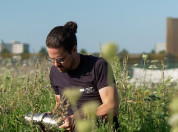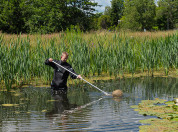Zoeken
Filteren op
Type
Labels
Dossiers
Thema's
Afdelingen
Taal
Active filters
1730 zoekresultaten
Zoekresultaten
-
Terrestrial Ecology
The department of Terrestrial Ecology studies species, communities & ecosystems in a rapidly changing world.
-
Dierecologie
De afdeling Dierecologie onderzoekt waarom dieren bepaalde eigenschappen hebben, hoe dit genetisch bepaald is en hoe dit verandert over tijd en plaats. We kijken bijvoorbeeld naar de verandering van populaties, qua aantallen en qua samenstelling. -
Aquatic Ecology
Our mission is to understand aquatic ecosystems, predict their responses to a changing world, and contribute to a sustainable future.
-
Ecology network
The Netherlands Institute of Ecology (NIOO-KNAW) performs leading ecological research. NIOO-researchers play a key role in the wider network of ecological science and knowledge., in the Netherlands and beyond.
-
Working at NIOO
With more than 200 staff and students, the Netherlands Institute of Ecology (NIOO-KNAW) is one of the largest research institutes of the Royal Netherlands Academy of Arts and Sciences (KNAW). Most are from the world of (international) science: professors, researchers and PhD students. They are joined by indispensable support staff in HR, Science Communication, Finances, ICT and Facilities. Everyone makes their own passionate contribution towards a more liveable world. Does that sound like you?
-
Privacy statement
Privacy statement -
King Willem-Alexander to visit NIOO on 6 July
On 6 July, His Majesty King Willem-Alexander will pay a working visit to the Netherlands Institute of Ecology (NIOO-KNAW) in Wageningen.
-
Koning bezoekt NIOO op 6 juli
Zijne Majesteit Koning Willem-Alexander brengt op woensdagmiddag 6 juli een werkbezoek aan het Nederlands Instituut voor Ecologie (NIOO-KNAW) in Wageningen.
-
Theses 2021
Proefschriften en theses verbonden aan NIOO-KNAW, gepubliceerd in 2021. -
Arbeidsvoorwaarden
We bieden een veelzijdig en flexibel arbeidsvoorwaardenpakket. Naast een aantrekkelijk salaris en regelingen conform de Cao voor de Nederlandse Universiteiten, is er een aanvullend arbeidsvoorwaardenpakket. Dit pakket voorziet in de verschillende behoeften die je als medewerker kunt hebben, afhankelijk van je levensfase en/of loopbaanambities. Hieronder vind je verschillende mogelijkheden.
